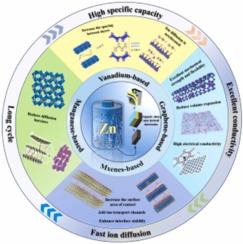迈向高能量密度和长期稳定锌离子电池的有机-无机杂化
IF 17.1
1区 材料科学
Q1 CHEMISTRY, PHYSICAL
引用次数: 0
摘要
锌离子电池(zib)作为一种安全、经济、环保的锂离子系统替代品而受到越来越多的关注,但其实际应用受到能量密度有限、离子动力学缓慢和循环稳定性差的阻碍。有机-无机混合电极将无机框架的结构稳健性和氧化还原活性与有机部分的可调节性和多电子氧化还原电位结合在一起,成为克服这些挑战的一种变革策略。本文综述了高性能ZIBs混合电极设计的最新进展,包括钒基、锰基、mxene基和石墨烯基系统。我们强调分子水平的设计原则,协同电荷存储机制和界面工程策略,这些共同使比容量,速率能力和长期耐久性得到显着改善。除了分析杂化的内在优势外,还对电极溶解、界面不稳定性和有限的可扩展性等关键瓶颈进行了批判性的讨论。最后,展望了分子工程、多功能复合材料和可持续加工的发展方向。本综述旨在启发下一代ZIBs的合理设计,使其结合高能量密度、长期稳定性和可扩展制造性,用于广泛的储能应用。本文章由计算机程序翻译,如有差异,请以英文原文为准。

Organic-inorganic hybrids toward high energy-density and long-term stable zinc-ion batteries
Zinc-ion batteries (ZIBs) have garnered growing attention as a safe, cost-effective and eco-friendly alternative to lithium-ion systems, yet their practical application is hindered by limited energy density, sluggish ion kinetics and poor cycling stability. Organic–inorganic hybrid electrodes, which integrate the structural robustness and redox activity of inorganic frameworks with the tunability and multi-electron redox potential of organic moieties, have emerged as a transformative strategy to overcome these challenges. This review presents a comprehensive and forward-looking summary of recent advances in hybrid electrode design for high performance ZIBs, including vanadium-based, manganese-based, MXene-based and graphene-based systems. We emphasize molecular-level design principles, synergistic charge-storage mechanisms, and interface engineering strategies that collectively enable remarkable improvements in specific capacity, rate capability and long-term durability. In addition to analyzing the intrinsic advantages of hybridization, key bottlenecks such as electrode dissolution, interfacial instability and limited scalability are critically discussed. Finally, we outline promising future directions in molecular engineering, multifunctional composites and sustainable processing. This review aims to inspire the rational design of next-generation ZIBs that combine high energy density, long-term stability and scalable manufacturability for broad energy storage applications.
求助全文
通过发布文献求助,成功后即可免费获取论文全文。
去求助
来源期刊

Nano Energy
CHEMISTRY, PHYSICAL-NANOSCIENCE & NANOTECHNOLOGY
CiteScore
30.30
自引率
7.40%
发文量
1207
审稿时长
23 days
期刊介绍:
Nano Energy is a multidisciplinary, rapid-publication forum of original peer-reviewed contributions on the science and engineering of nanomaterials and nanodevices used in all forms of energy harvesting, conversion, storage, utilization and policy. Through its mixture of articles, reviews, communications, research news, and information on key developments, Nano Energy provides a comprehensive coverage of this exciting and dynamic field which joins nanoscience and nanotechnology with energy science. The journal is relevant to all those who are interested in nanomaterials solutions to the energy problem.
Nano Energy publishes original experimental and theoretical research on all aspects of energy-related research which utilizes nanomaterials and nanotechnology. Manuscripts of four types are considered: review articles which inform readers of the latest research and advances in energy science; rapid communications which feature exciting research breakthroughs in the field; full-length articles which report comprehensive research developments; and news and opinions which comment on topical issues or express views on the developments in related fields.
 求助内容:
求助内容: 应助结果提醒方式:
应助结果提醒方式:


